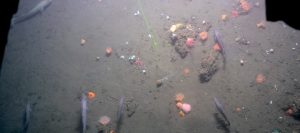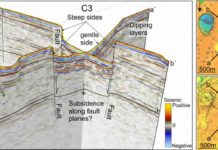
Scientists have calculated that the present day ice sheets keep vast amounts of climate gas methane in check. Ice sheets are heavy and cold, providing pressure and temperatures that contain methane in form of ice-like substance called gas hydrate. If the ice sheets retreat the weight of the ice will be lifted from the ocean floor, the gas hydrates will be destabilised and the methane will be released.
Studies conducted at CAGE have previously shown that ice sheets and methane hydrates are closely connected, and that release of methane from the seafloor has followed the retreat of the Barents Sea ice sheet some 20,000 years ago. But is all such release of the potent climate gas bound to be catastrophic?
Not necessarily, according to a new study published in Nature Communications. It shows that the methane was indeed released as the ice sheets retreated. However the seepage did not occur in one major pulse, but over a period of 7000 to 10000 years following the initial release.
“The release was too slow to significantly impact the concentration of methane in the atmosphere.” says researcher and project leader Aivo Lepland at Norwegian geological Survey (NGU) and CAGE.This may help explain why we have yet to discover a signal for such events in the various climate records of the past.
Radioactive material tells time
A new and groundbreaking method of dating carbonate rocks has been used to come to this conclusion. The seepage of methane over a long period of time created perfect conditions for formation of a special type of rock called authigenic carbonate crust. This could than be dated by scientists by a using a radiometric technique to measure natural decay of uranium to thorium.
“We have used carbonate crusts that form just below the sea-floor. They are a direct result of the oxidation of methane moving upwards though the sediment layers from deeper reservoirs. The chemical composition of the crust tells us that the source fluid was methane-rich, and the uranium-thorium dating tells us when this methane release happened.” explains lead author of the study Antoine Cremiere, post.doc at NGU/CAGE.
Knowledge of the timescales of gas hydrate dissociation and subsequent methane release are critical in understanding the impact of marine gas hydrates on the ocean-atmosphere system, says Shyam Chand, researcher at NGU/CAGE.
Paper reference: Cremiere et. al. Timescales of methane seepage on the Norwegian margin following collapse of the Scandinavian Ice Sheet. Nature Communications 7, May 2016.
Video
Reference:
Antoine Crémière, Aivo Lepland, Shyam Chand, Diana Sahy, Daniel J. Condon, Stephen R. Noble, Tõnu Martma, Terje Thorsnes, Simone Sauer, Harald Brunstad. Timescales of methane seepage on the Norwegian margin following collapse of the Scandinavian Ice Sheet. Nature Communications, 2016; 7: 11509 DOI: 10.1038/ncomms11509
Note: The above post is reprinted from materials provided by CAGE – Center for Arctic Gas Hydrate, Climate and Environment.










